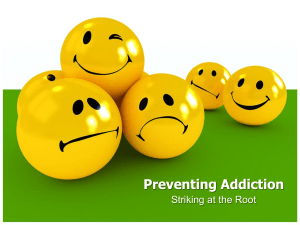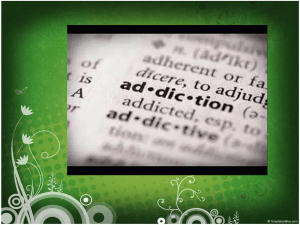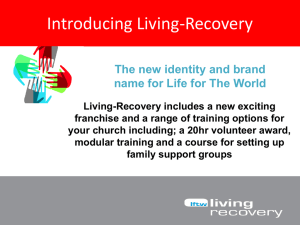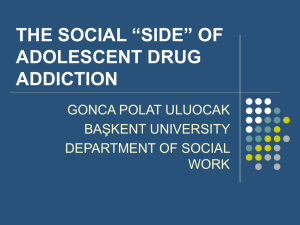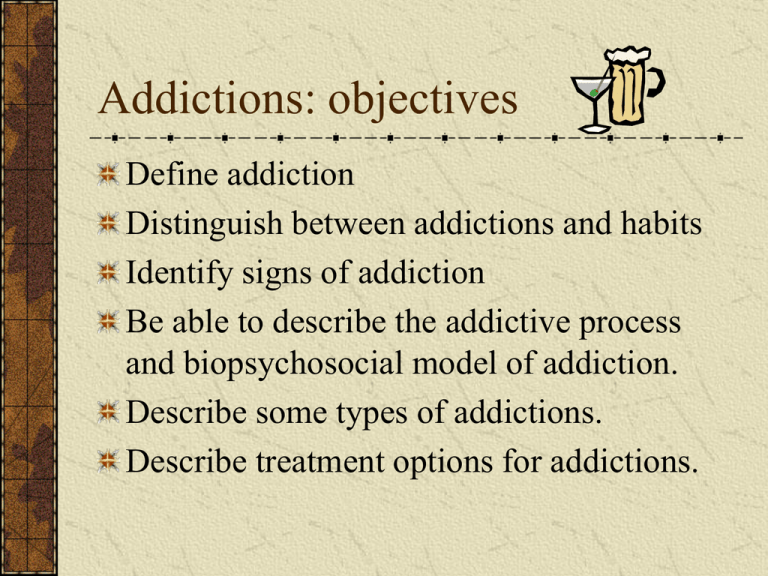
Addictions: objectives
Define addiction
Distinguish between addictions and habits
Identify signs of addiction
Be able to describe the addictive process
and biopsychosocial model of addiction.
Describe some types of addictions.
Describe treatment options for addictions.
Addiction is defined as:
Continued involvement with a substance or
activity despite ongoing negative
consequences(not getting work done, ….)
Initially this addictive behavior provides
some pleasure or stability that is beyond the
addict’s power to achieve in other ways.
Eventually the addicted person needs to be
involved in the behavior to feel “normal”.
Addiction can be:
Physiological-actual chemical need and
when the substance is removed the person
suffers withdrawal symptoms: headache,
nausea, vomiting, diarrhea, stomach pains,
fatigue, etc.
Psychological (e.g. gambling)
Both are interrelated because everything
you feel is tied to a chemical state.
The addictive process:
Are not well understood, but, probably
reflect some dysfunction of certain
biochemical systems in the brain.
There is some research that points to the
link of genes inherited from our parents
(who may be addicts) to predispose a person
to addictions.
There are many factors that
influence addictive behavior:
Unresolved issues from childhood.
Family dysfunction
Conflict and stress
In adolescence or young adults that are shy
may wish to be less inhibited and start
experimenting with alcohol.
Peer pressure or social “norms”.
Tolerance:
Is defined as needing more and more of the
addictive substance to feel the “high” or
particular level of relaxation.
It doesn’t matter if the substance is alcohol,
cannabis or tobacco.
Habit vs. addiction:
Addiction involves an element of habit- a repeated
behavior in which the repetition may be
unconscious..
A habit can be broken without too much
discomfort.
In addiction, the habit is a compulsion that has
gotten out-of-control.
Habits are more in the realm of choice and do not
cause a lot of negative consequences: missed
work, school, failed test, fights, ill health affects.
Signs of Addiciton:
We all engage in potentially addictive
behaviors that cause pleasure such as;
eating, drinking alcohol, sex, internet
surfing, etc.
At some point individuals utilize these
activities as a prolonged escape, or
“medication” for some ill feelings
(conscious or unconscious).
Four common symptoms:
Compulsion which is characterized by
obsession or excessive preoccupation and
overwhelming need.
Loss of control
Negative consequences: missed class, work.
Chronic tardiness, damage to property, legal
and/or financial problems
Denial or inability to perceive the behavior
as self-destructive.
The addictive process:
Occurs over time, it begins when a person
repeatedly seeks relief to avoid unpleasant
feelings or situations.
This pattern is known as “nurturing through
avoidance” and is a maladaptive way of
taking care of emotional needs.
There may be some deterioration of
relationships or other problems or they may
be very “functional”.
Emotional pain
Craving for relief
More pain,
low-self esteem
preoccupation
Depression, guilt
shame
Substance use
Negative
consequences
Short
Short term
term
relief
relief
The physiology of addiction:
All intellectual, emotional and behavioral
functions occur as a result of biochemical
interactions between nerve cells.
How many of you have heard about
endorphins?
Endorphins are chemicals that are similar to
morphine and were discovered because
there are receptor sites in the brain.
There are also receptor sites for marijuana
and some of us produce chemicals in our
brain that similar to marijuana.
When the drug use stops, those receptor
sites are empty…
Resulting in uncomfortable feelings until
the body creates the substance or ingests the
drug.
So…people genetically +/or naturally
produce less endorphins so they seek out
drugs and/or activities that increase
endorphins.
So people are wired or it is on their “hard
drive” to seek out chemicals or activities.
When a person stops the
Activity or chemical they feel
Depression, anxiety, irritability
Frustration and anger as well
As the physical symptoms
Already mentioned
The biopsychosocial model of addiction:
Based upon the biological and disease
model as well as the psychological and
environmental factors that contribute
to addiction.
The bio part looks at how the physiology of
an addict is different from a non-addict.
When all factors are considered the success
rate increases.
We talked about neurotransmitters,
usually the addict has low:
serotonin
Norepinephrine
Endorphins
enkephalin
Environmental influences:
Cultural expectations and mores help to
determine whether a person engages in
specific behaviors.
Medias influence on appearance
And the ideal body plays a role in exercise
addiction.
Societal glorification of money
And material achievement can lead to work
addiction.
Major stressful events can trigger
addictive behaviors:
Marriage
Divorce
Unemployment
Death of a loved one
People who suppress their
Emotions and try to “keep the peace” are
more prone to addictions.
Children whose parents are not available
emotionally and/or physically are more
prone to suffer addictions in adulthood.
Persons with low self-esteem, risk-taking
and poor coping skills have a tendency
towards addictions.
10 million people in the U.S.
Are involved with some type of self-help
group so they have identified some type of
disorder.
Other types of Addictions:
Compulsive gambling
Spending/borrowing
About 80% of college students
Work Addiction:
Healthy work helps us to have a sense of
identity and can help us to develop our
strengths and mastery of problems.
Healthy work does not “consume” the
worker.
Work is an addiction when it is compulsive
and used to fill the need for intimacy.
Characterized by obsession, perfectionism,
fear, low self-esteem.
Work addiction can be a source
Of marital or relationship problems
Work addicts become emotionally
crippled-losing communication
And human interaction skills.
Addicts can have extreme
Difficulty relaxing and playing.
They suffer frequently from chronic fatigue.
Exercise Addiction: exercise is a powerful
mood enhancer
2 million suffer from anorexia +/or
bulemia(Vomiting)
Addiction affects family and friends
by:
Inducing co-dependency behaviors-people
get addicted to “helping the addict”.
Co-dependants have a difficult time setting
limits.
Treatment and Recovery:
Recognize the addiction
Many times the addict cannot “see the
truth”.
Abstinence is refraining from the addictive
behavior.
Sometimes detoxification may need to
occur.
12 step programs:
Spiritually based, addicts helping addicts,
inexpensive, usually convenient, high
success rate.
Professional counseling, many times much
more mental health based, can be
expensive.
Relapse occurs if the wound hasn’t
sufficiently healed.
Summary:
Addiction is continued involvement with a
substance or activity that has negative
consequences.
Habits are repeated behaviors, whereas
addiction is a behavior that is compulsive.
Addiction is a process, evolving over time,
involving nurturing through avoidance.
There is a biopsychosocial model of
addiction.




